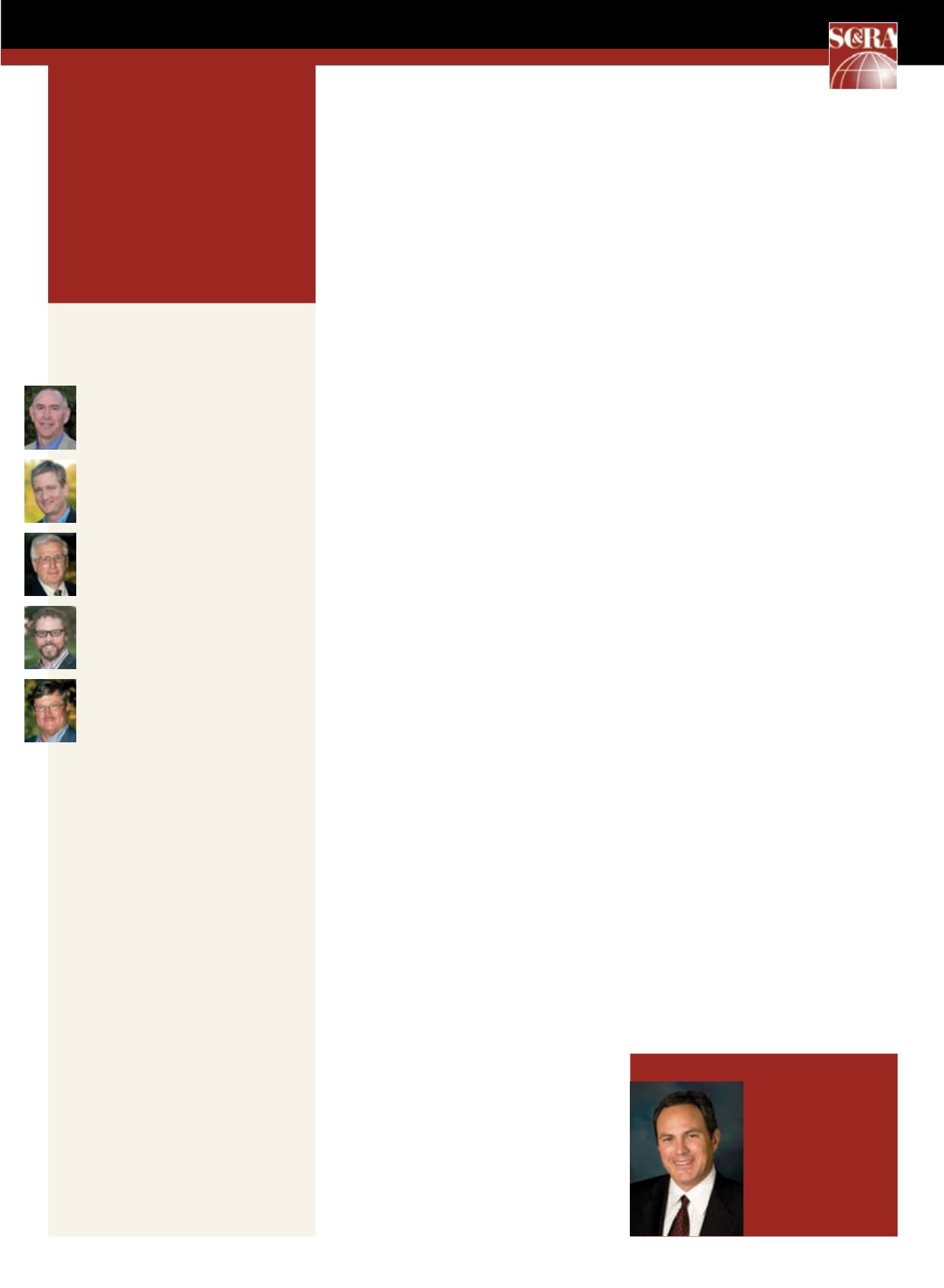
57
COMMENT
Who’s who at the
Specialized Carriers
&Rigging Association
CHAIRMAN
RonMontgomery
Intermountain Rigging & Heavy Haul
Salt Lake City, UT
PRESIDENT
AlanBarnhart
Barnhart Crane and Rigging
Memphis, TN
VICE PRESIDENT
Bruce Forster
Rigging Gear Sales
Dixon, IL
TREASURER
DelynnBurkhalter
Burkhalter
Columbus, MS
ASSISTANT TREASURER
JohnMcTyre
McTyre Trucking
Orlando, FL
ALLIED INDUSTRIESGROUP CHAIRMAN
Eddy Kitchen
, Kitchens Crane &
Equipment
Chesterfield, VA
CRANE&RIGGINGGROUP CHAIRMAN
Larry Curran
, JJ Curran Crane Company
Detroit, MI
LADIESGROUP CHAIRWOMAN
KarenWood
,Wheco
Richland,WA
TRANSPORTATIONGROUP CHAIRMAN
Jay Folladori
, Landstar
Jacksonville, FL
SC&R FOUNDATIONOFFICERS
President:
RobertMoore,
NBIS
Atlanta, GA
Vice President:
Stephanie Bragg,
Bragg Companies
Long Beach, CA
Treasurer:
Jim Sever
PSC Crane & Rigging,
Piqua, OH
T
here are someobviouswinners
and loserswhenoil prices drop.
While consumers and energy-
intensive industries exult, oil exploration
firms, fossil fuel-dependent countries
and evenhybrid carmanufacturers aren’t
exactly jumping for joy.And as the trend
reverses itself, as itmost assuredlywill
in time, the reactions of the applicable
winners and loserswill also adjust
accordingly.
Fornow, a combinationof increased
production stateside, combinedwith
subdueddemand, has causedWest
Texas IntermediateCrude (as a familiar
example) to fall froma spot priceof $109
in the summerof 2014 toaround$50as
of lastmonth.
Thus, the transportation sector is
benefitting, not onlydirectly– from
lower fuel costs–but alsodue to the
increase in consumer spending,which is
energizingglobal trade and stimulating
economies around theworld.However,
many transportation companies are
approaching thisnewnormwith cautious
optimism,mainlybecause it’sunclear
how long the lowpriceswill last –which
isprovokinganewwaveof strategic
questions across the industry.
Indeed, airlines likelybenefit themost
from reducedoil prices–approximately
a thirdof their costs are associatedwith
fuel.Andwhereas airline companies
around theworldmight be encouraged
to increase fleet size,modernize fleets,
or enhance customer experience, a swift
increase inoil prices could createquite
a logjam.Airlines should remain careful
about assuming long-term capacity
expansionand/or complex customer
experience enhancementswhen fuel costs
remainunpredictable.
Fuel prices drop
According to
strategy+business
, some
key strategicquestions for the airline
industry include: Shouldnew, previously
unprofitable routesbe reexamined?How
much, if any, capacity shouldbe added?
What is theoptimal fleetmix, and should
olderplanesbe re-commissioned?
Alsobenefiting from thedrop in fuel
prices is the freight rail industry. Though
the savings for rail aren’t quite evenwith
theairline industry (approximately20
percent), it’sneverthelessbeenquite a
perk for rail companies. But still, in times
of lowoil prices, rail companiesdiscover
competitive challenges–mostly from
trucking. Typically, customersprefer rail
to trucking for long-haul routesbecause
rail costs less, but in timesof low fuel
costs, truckers aregetting thenodmore
andmore, because it is generally faster.
It’s adelicatebalance for rail; reduced
oil priceshave customers lookingat truck
transport andweighing the cost/speed
scenario. Rail companiesmust continue
to consider somekey strategicquestions
of theirown:Howwill loweroil prices
affect intermodal dynamics?What is the
expected impact of losingoil shipments
andoil-related services?Andwhat is the
most effectiveway to retain customers–
especially thosegained from trucking?
Whichbringsus to familiar territory:
trucking. This industryactuallyhas the
potential tobenefit both in the short and
long-term from thedrop in fuel costs.As
mentionedabove, thegapbetween rail
vs. trucking transport costshasnarrowed
significantly.Operating companies are
enjoyinghighermargins, allowing them
topass someof the savingson to the
customerwhile alsoattempting to regain
manyof the customers they’ve lostwhile
priceswerehigher.
Lower costs alsoallow truck companies
todesignoperations arounddemand,
versus fuel considerations. This
allows them to evolve their routes
andnetworks tobetter serve their
customers.Additionally, lowerprices
allow companies tokeepolder vehicles
on the road longer–as longas theymeet
emissions standards.
But aswithairline and rail, trucking
companies should remainvigilant
in regards to thevolatilityof theoil
economy.Key strategicquestions include:
Should investments inalternative fuel
vehicles continue accordingly?Which
current rail companies are losing their
griponbusiness?Andwhat adjustments
shouldbemade to thenetwork tomost
benefit customers?
■
APRIL 2015
ACT
Lower fuel costs
expose key strategic
questions.
EXECUTIVEVICE PRESIDENT
Joel Dandrea
5870 Trinity Centre
Parkway,
Suite 200
Centreville, VA
20120
Ph: 703-698-0291
Fax: 703-698-0297
Strategic questions


